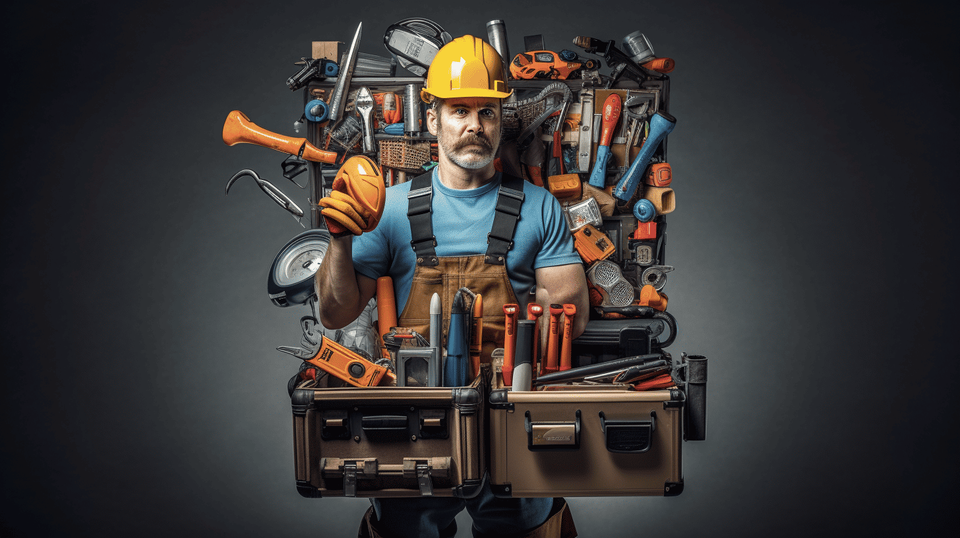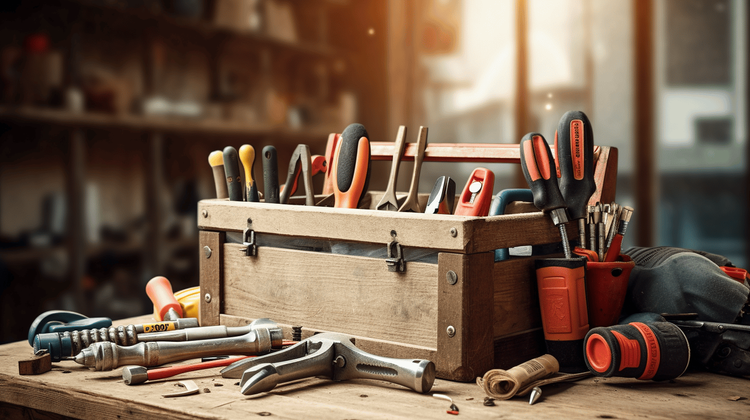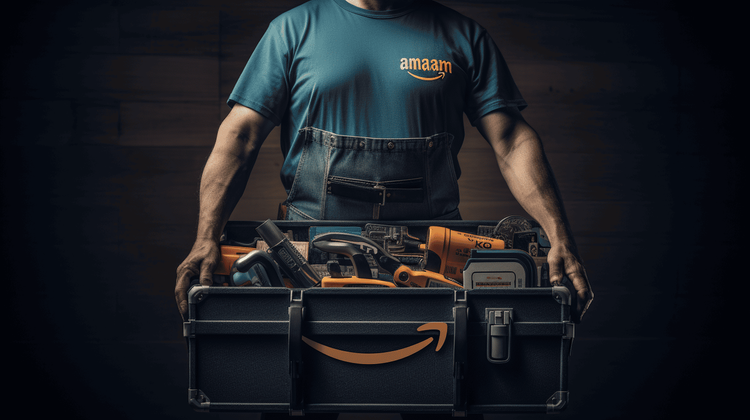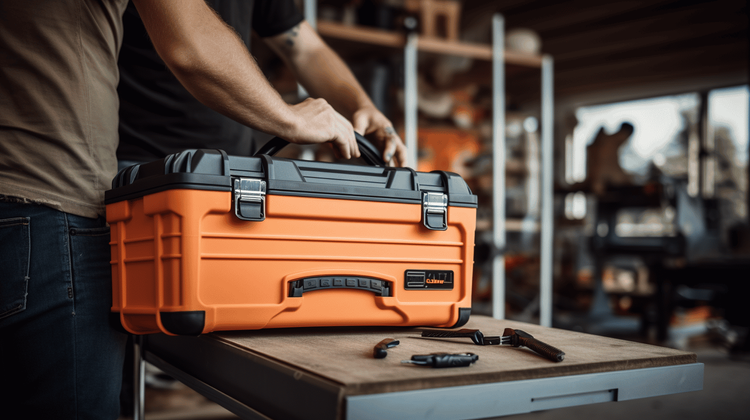Defying Budget Constraints: Best DIY Tools on eCommerce Platforms

Welcome, thrifty renovators and DIY enthusiasts! 🛠️ We all know that satisfying feeling after completing a hands-on project, all through our own...hands. However, that road to triumph is often redirected by cost constraints. Persistent but budget-conscious DIYers alike, this guide is for you! Here we dive into an ultimate guide – exploring affordable tools, providing top-notch recommendations, and shedding light on the art of doing-it-yourself while dodging those budget bulldozers. Strap in for an insightful journey into the world of smart, cost-effective DIY adventures - let's redefine the meaning of 'budget constraints' together.
Understanding the Budget Constraints
Have you ever been excited about a new idea for your business, only to be stopped in your tracks by budget constraints? It can feel like a punch in the gut. But guess what? You're not alone. Virtually every business, regardless of its size or industry, grapples with financial limitations. In essence, understanding the budget constraints is a fundamental step to ensure your business’ financial health and growth 📈.
Before we jump into the discussion, let's first establish the base. What do we mean by budget constraints? The term refers to financial limitations that make it impossible or challenging to meet business objectives. These constraints can stem from a variety of sources such as economic fluctuations, cuts in funding, or increased costs in production or operations.
Frankly speaking, understanding budget constraints requires a careful examination of the following elements:
- Revenue: This is the money your business earns from sales of its products or services. It sets the upper limit for your budget. Consider the sales forecasts for predicting the possible revenues.
- Fixed costs: These are recurring costs like rent, salaries, utilities, etc. Irrespective of your business's revenues, these expenses must be paid.
- Variable costs: Expenses that vary with the production level, such as raw materials, are considered variable costs. They directly correlate with your production output 📊.
- Profits: The left-over money after all costs and expenses have been deducted from revenues. It directly impacts your budget for reinvestment or future growth.
"If you know the enemy and know yourself, you need not fear the result of a hundred battles." A quote from Sun Tzu's Art of War certainly holds true for understanding budget constraints. Without a clear understanding of these elements, it's like navigating a ship 🚢 without a compass.
So how can you effectively manage budget constraints? There's no "one-size-fits-all" approach, but below are some tactics that might help:
- Regular forecasting and budgeting: These guide your overall spending and aid in catching any financial issues before they spiral out of control.
- Investing wisely: Allocate funds 🏦 into areas that promise the highest returns.
- Reducing unnecessary costs: Utilise resources efficiently and cut down on any wastage.
Remember, understanding budget constraints is not just about identifying limitations. It's also about finding opportunities to maximize efficiency and profitability. It's about turning hurdles into stepping stones for growth. Sure, managing budget constraints can be hard, but then again, nothing worth having comes easy, does it?
DIY Projects for the Budget Conscious
Feeling pinched by your limited budget but yearning to spruce up your living space? No need to fret! There's a silver lining in the universe of Do-it-Yourself (DIY) projects! 🌈 From pallet furniture to homemade decor, DIY projects can help you defy budget constraints while also providing a productive and creative outlet.
Defying Budget Constraints
Budget constraints are like stubborn jar lids; they can be hard to crack! But with DIY projects, you become the superhero with the strength to break the seal. 💪
Here's how DIY projects can work around budget limitations:
- Streaming costs down: Buying a readymade piece of furniture or decor can be a financial commitment. However, DIY gives you the flexibility to work as per your budget and at your own pace.
- Bargain hunting: With DIY, you get to source your accompanying materials, which allows for bargain hunting in flea markets, online trading spaces and even your garage! You could potentially save a fortune on materials!
- Recycle and Create: By reusing and repurposing materials, DIY not only reduces costs, but also minimizes environmental impact. 🌳
Unleashing your creative juices on budget-friendly DIY projects is not only economically savvy, but it also fosters a sense of accomplishment and satisfaction.
Benefits of DIY Projects
DIY projects offer more than just money-saving advantages. Check out these additional benefits:
- Developing Handy Skills: Learning how to utilize different materials and tools can equip you with skills and knowledge that can be carried forward into different areas of your life. 🔨
- Creative Outlet: Express yourself through your projects! Creativity promotes overall happiness, reduces anxiety and fills life with a sense of purpose. 🎭
- Self-satisfaction: When you create something all by yourself and it turns out to be a masterpiece, the sense of achievement is beyond words. 🏆
The bottom line? Don't let budget constraints dim your home improvement dreams. You now have the power to redefine your environment, use your creativity, and save resources all at the same time. Embrace the realm of DIY projects, and dance to the rhythm of your hammer and nails! 🕺💃
Essential DIY Tools Everyone Should Have
From hanging a picture frame to building a custom piece of furniture, having the right tools can make all the difference. There's a certain satisfaction and sense of accomplishment that comes from DIY projects. Whether you're mending something broken or creating something new, you're not just saving money - you're also expressing your creativity and ticking a task off your to-do list. But before you take on your large or small DIY endeavor, be sure you're equipped with these four categories of essential tools: measuring, cutting, fastening, and finishing. 🛠️
Measuring Tools
If you want your projects to fit - literally - then you need to start by getting the measurements right. Measuring tools will help you achieve precision and accuracy. Some must-have measuring tools include:
- A measuring tape: For quick and straightforward distance measurements.
- A carpenter's square: To get perfect 90-degree angles.
- Gauges and calipers: For detailed measurements of interior and exterior dimensions.
- A level: To ensure your project isn't on a slant!
Cutting Tools
A good set of cutting tools is essential for any serious DIY enthusiast. With their help, you can shape materials to your specifications, like a sculptor with stone. Key cutting tools to consider include:
- A utility knife: This versatile tool is great for precision cuts or opening packages.
- Saws: A handsaw or circular saw is crucial for cutting larger pieces of wood.
- Scissors: Don't underestimate this everyday tool - it's perfect for cutting paper or fabric.
- A chisel: For specific tasks such as carving or shaving wood.
Fastening Tools
After the measuring and cutting, it's time to put everything together. Fastening tools are the backbone of a solid and secure project. Make sure your toolbox contains:
- A hammer: For nails, and you know, those frustrating moments when things don’t go as planned. 🛠️
- Screwdrivers: Both flathead and Phillips head varieties.
- A wrench or socket set: Perfect for working with bolts and nuts.
Finishing Tools
The finishing phase of a project is often regarded as the most satisfying. These tools ensure your project looks neat and complete, ready for the world to admire. Essential finishing tools include:
- Sandpaper or a sander: For smooth, splinter-free surfaces.
- Painter's tape: To create clear edges when painting.
- A paintbrush and roller: To apply your chosen colors.
- A sealant or varnish: To protect your finished work.
The beauty of starting your collection of essential DIY tools is that your skills and capabilities will grow with time. Before long, you'll be building, mending, and creating like a pro. Remember, it's about more than just doing it yourself – it's about the joy of proudly saying, "I did this." Now, roll up those sleeves and let the DIY adventure begin! ✨
Budget-Friendly DIY Tools on eCommerce Platforms
Whoever said you needed to be a certified professional to turn your vision into reality? Thanks to countless eCommerce platforms, we live in an age where everyone can undertake amazing DIY projects and let their creativity shine! But wait; don't let your enthusiasm cut a hole in your pocket. This guide will introduce you to budget-friendly DIY tools that will make your projects a breeze without breaking the bank! 🛠️💸
Affordable Power Tools
Power tools often form the backbone of DIY projects—after all, their efficiency and precision can significantly reduce manual labor. But this doesn't mean you have to shell out oodles of money on them. eCommerce platforms have a plethora of affordable power tools at your disposal. Here are few of them that you might find interesting:
- Compact circular saws 🗜️: These efficient, pocket-friendly tools are great for DIY crafts and arguably form an essential part of the DIYer's toolbox.
- Cordless drills 🔩: As economical as they are convenient, cordless drills enable you to work unhindered by pesky cables.
- Air compressors 🌬️: Initially, you might think that air compressors are beyond your budget. However, many eCommerce platforms offer them at surprisingly friendly prices. Plus, they can be a game-changer for those painting or inflating tasks!
Viable Hand Tools
While power tools help significantly, hand tools, too, play an indispensable role in most, if not all, DIY endeavours. Not only are they an affordable choice, but these tools also promise precision and control that power tools sometimes lack. Consider adding these to your DIY toolkit:
- Screwdriver sets 🔩: No toolbox is ever complete without a good, durable set of screwdrivers. Since they are used extensively, investing in a high-quality set won't pinch your pocket.
- Hammers 🔨: A classic, sturdy hammer can come to your rescue more often than you'd think!
- Adjustable wrenches 🛠️: Adjustable wrenches are incredibly versatile and can save you from buying a whole set of differently-sized wrenches.
Cost-effective Outdoor Tools
Picture this—you're spending a lovely weekend in your backyard, ready to show off your DIY prowess, only to realise your outdoor tools may dig a hole into your savings. Fret not, as online shopping platforms have got your back with their cost-effective outdoor tools. Allow me to unveil some of them:
- Garden racks and hoes 💐: These tools are a gardener's best friends, and they're budget-friendly too!
- Pruning shears 🌲: Essential for maintaining plants, pruning shears are a must for gardening enthusiasts.
- Watering equipment 🚿: From watering cans to garden hoses, these are low-cost investments that aid in maintaining a healthy garden.
The list of budget-friendly tools available on eCommerce platforms is endless. Remember, good tools do not have to be expensive. The art and joy of DIY lie in creating something stunning and useful with minimal resources. So, roll up your sleeves, warm up that shopping cart, and prepare to embark on your DIY journey today! 💪🛍️
How to Choose the Right Tools for Your Project and Budget
You might be playing with the idea of embarking on that DIY project you saw on a late-night home improvement show, or perhaps you're simply dabbling at a new hobby that requires a hands-on, tactile approach. Whatever the reason, one thing is clear: you'll need the right set of tools. The path to the hardware store, however, is fraught with risks. Many an inexperienced shopper has found themselves overwhelmed by the dazzling array of tools on offer. But don't worry, this guide will help make sense of the chaos. Here's how to choose the perfect tools for your project and budget. 🛠️💡
Determining the Materials You Will use
Every project requires a different set of resources, and your tool requirements hinge on the materials you're planning to work with. Are you attempting to build a shelf from raw timber? Perhaps you're crafting a personalized necklace out of semi-precious stones. Each material demands custom tools:
- Wood: If you're working with wood, you may need saws to cut it, clamps to glue pieces together, and a variety of sanders to smooth out rough edges.
- Metal: A metal project may require tools like a hacksaw for cutting, a file for shaping, and a drill for creating holes.
- Stones and ceramics: For delicate work with stones or ceramics, a pair of needle-nose pliers or a jeweler’s file might be the way to go.
Identifying the Required Operations for Your Project
Beyond material selection, the nature of your project’s operations will dictate the necessary tools. For instance, if you are drilling holes, both a power drill and drill bits are needed. If you're cutting, you might need a handsaw, a coping saw, or even a power saw, depending on your project. Here's a quick list to guide you:
- Drilling operations:
- Power drill
- Drill bits of different sizes
- Cutting operations
- Hacksaw
- Handsaw
- Power saw
- Sanding operations
- Belt sander
- Random orbital sander
Determining Your Budget
Lastly, you'll want to have a realistic budget in mind to avoid undue financial strain. There is no point in acquiring high-end, professional-grade equipment for a one-off project. On the other hand, if you anticipate regular tool usage, investing in durable, quality tools might save you money in the long run as you won't have to constantly replace them. Here are some factors to weigh as you outline your budget:
- Expected frequency of tool usage
- Your project's complexity
- The tool’s lifetime value
Balancing these aspects can help you make an informed decision when choosing the right tools for your project and budget.
Remember, the goal is not to amass a collection of flashy tools. Instead, focus on acquiring what you need for your specific project, enhancing your craft, and keeping within your budget. After all, the best tool is the one that gets the job done without breaking the bank. 🛠️💰
Conclusion
Embracing the DIY lifestyle isn't just a budget-saving strategy; it’s about unleashing the creative force within and achieving a sense of accomplishment. Choosing the right tools for your project doesn’t have to be daunting or take a toll on your wallet.
Remember, how well your tools perform also matters. Cheap, low-quality tools can add unnecessary frustration and time to your DIY projects. Choose your tools wisely, investing, when possible, in versatile tools that can be useful across multiple tasks. If you're starting, your essentials list could include measuring, cutting, fastening, and finishing tools.
Navigating the vast world of eCommerce platforms can be a bit overwhelming, but with trusted sites like Ultra Handy, you can rest easy. Not only you will find a vast range of affordable and reliable tools, but also healthy supplements to keep you at your best during your DIY ventures.
One standout product is the Bit Holder Keychain. It's the perfect tool for any DIY enthusiast or professional in physical jobs. It helps to organize your bits and make them readily available for the weighty home improvement projects or small repair tasks.
So there you have it, fellow DIYers. With a clear understanding of your project needs, the right tools, and a little bit of guidance from trusty eCommerce sites such as Ultra Handy, your home improvement dreams can indeed become reality without breaking the bank. Keep crafting, keep creating, and most importantly, keep defying those budget constraints. After all, who said good things must come with a hefty price tag?
Frequently Asked Questions
- What are some of the best DIY tools available on eCommerce platforms?Some of the best DIY tools available on eCommerce platforms include: 1. Shopify, 2. WooCommerce, 3. BigCommerce, 4. Magento, and 5. Squarespace.
- What is the advantage of using DIY tools on eCommerce platforms?Using DIY tools on eCommerce platforms allows you to create and customize your online store without the need for coding or technical expertise. These tools provide user-friendly interfaces, templates, and plugins to help you easily build and manage your eCommerce website.
- Do I need programming skills to use DIY tools on eCommerce platforms?No, you don't need programming skills to use DIY tools on eCommerce platforms. These tools are designed to be user-friendly and require no coding knowledge. They provide intuitive interfaces and drag-and-drop functionality to make website creation and management accessible to everyone.
- What factors should I consider when choosing a DIY tool for my eCommerce website?When choosing a DIY tool for your eCommerce website, consider factors such as ease of use, available templates and designs, integrations with payment gateways and shipping providers, scalability, customer support, and pricing. Assess each tool's features and capabilities to ensure it aligns with your business needs.
- Can I migrate my existing eCommerce website to a DIY platform?Yes, most DIY platforms offer migration options to help you transfer your existing eCommerce website. They provide tools and documentation to guide you through the migration process smoothly. However, it's recommended to backup your data and thoroughly test the migrated site to ensure everything works correctly.




